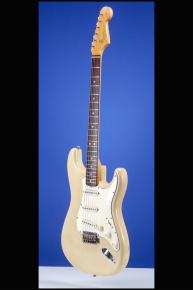Gentlemen Prefer Blonds…
1965 Fender Stratocaster.
This "transition" Stratocaster weighs just 7.80 lbs. and has a nice, fat nut width of just under 1 11/16 inches and a scale length of 25 1/2 inches. Solid ash body, contoured on back and lower bass bout, one-piece maple neck with a nice, medium profile, and veneer rosewood fretboard with 21 frets and pearloid dot position markers. Small headstock with early 1965 "transition" logo with "Fender" in gold with thin black outline, "STRATOCASTER" in black beside it, "WITH SYNCHRONIZED TREMOLO" in black beneath it, and five patent numbers in black beneath that. "Original Contour Body Pat. Pend." decal on the ball end of the headstock. Single "butterfly" string tree with nylon spacer. The neck is stamped "2 NOV65 B" and the pots are dated "304 6532" (Stackpole August 1965). Individual dual-line Kluson deluxe tuners with oval nickel-plated buttons, with "D-169400 PATENT NO" stamped on the inside. Four-bolt Fender "F" series neck plate with serial number ("107969") between the top two screws. Three white plastic-covered "grey-bottom" single-coil pickups with staggered polepieces and balanced outputs of 5.92k, 5.91k, and 5.77k. Three-layer (white/black/white) celluloid pickguard with eleven screws. Three controls (one volume, two tone) plus three-way pickup selector switch, all on lower treble side of pickguard. White plastic knobs with green lettering. Jack socket in body face. Fender "Synchronized Tremolo" combined bridge/tailpiece. This guitar is in excellent plus (8.75) condition. It has been expertly and invisibly re-fretted with slightly wider gauge frets. There are two noticeable areas of wear on the body, the largest being on the edge of the lower waist and the other on the edge of the upper horn. The other marks are small surface chips and are really of little significance. Overall, this is one of the cleanest See-Through Blonds that we have ever seen and the slightly larger gauge frets really do improve the playability of this wonderful sounding forty-nine-year-old beauty. A real treasure -- complete with the original black leather strap and 1965 Fender catalog. Housed in the original Fender black hardshell case with orange plush lining (8.00).
"Gentlemen Prefer Blonds (Ash Bodies). When looking at custom colored Fenders, keep in mind what wood the body is constructed from. After mid-1956, all custom colored Fenders (except Blond and the 1963 red mahogany-body Teles) should be Alder, not Ash. This applies to Teles, Strats, Jazzmasters, everything. But right now I bet you're thinking, 'hey, aren't pre-CBS Teles always made of Ash?'. The answer to this depends on the color…I believe the reason the majority of Telecasters and Esquires are made of Ash is because their standard finish was blond. They aren't made of Ash just because they're Teles. Fender Blond finishes, because they are translucent, are always painted over Ash. Any other finish (after 1956), uses Alder. The reason is purely time and money. Ash, because it requires the additional step of 'pore filling' (see above), requires more time and work to paint. That's why Fender switched to Alder in mid-1956. Alder is just a lot easier and cheaper to paint. Strats are a different story. After mid-1956, if it's a custom color other than Blond, it's got to be an Alder body. Since after mid-1956 Strats 'standard' body wood was Alder, you only see Ash bodies on Blond models" (http://www.provide.net/~cfh/fenderc.html).
"After July 1962, a 'curved' rosewood fretboard (i.e. with a convex base) replaced the 'slab' board. At first, the rosewood cap remained fairly thick, but by 1963 it turned into a thinner veneer and it was kept this way until mid-1983" (A.R. Duchossoir, The Fender Stratocaster, p.48).










